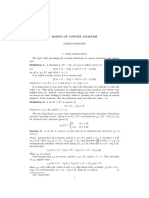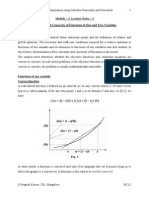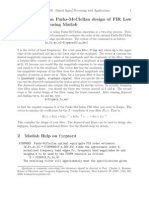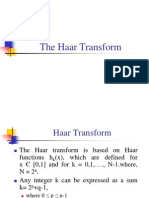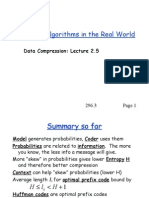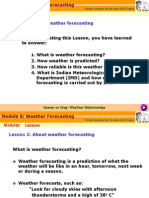Convex Function: From Wikipedia, The Free Encyclopedia
Uploaded by
Rakesh InaniConvex Function: From Wikipedia, The Free Encyclopedia
Uploaded by
Rakesh Inani10/14/2014
Convex function - Wikipedia, the free encyclopedia
Convex function
From Wikipedia, the free encyclopedia
In mathematics, a real-valued function f(x) defined on an interval is
called convex (or convex downward or concave upward) if the line
segment between any two points on the graph of the function lies above
the graph, in a Euclidean space (or more generally a vector space) of at
least two dimensions. Equivalently, a function is convex if its epigraph
(the set of points on or above the graph of the function) is a convex set.
Well-known examples of convex functions are the quadratic function
and the exponential function
for any real
number x.
Convex functions play an important role in many areas of mathematics.
They are especially important in the study of optimization problems
where they are distinguished by a number of convenient properties. For
instance, a (strictly) convex function on an open set has no more than
one minimum. Even in infinite-dimensional spaces, under suitable
additional hypotheses, convex functions continue to satisfy such
properties and, as a result, they are the most well-understood functionals
in the calculus of variations. In probability theory, a convex function
applied to the expected value of a random variable is always less than or
equal to the expected value of the convex function of the random
variable. This result, known as Jensen's inequality, underlies many
important inequalities (including, for instance, the arithmeticgeometric
mean inequality and Hlder's inequality).
Convex function on an interval.
A function (in black) is convex if and only if the
region above its graph (in green) is a convex set.
Exponential growth is a special case of convexity. Exponential growth
narrowly means "increasing at a rate proportional to the current value", while convex growth generally means "increasing at
an increasing rate (but not necessarily proportionally to current value)".
Contents
1 Definition
2 Properties
3 Convex function calculus
4 Strongly convex functions
4.1 Uniformly convex functions
5 Examples
6 See also
7 Notes
8 References
9 External links
Definition
Let X be a convex set in a real vector space and let f : X R be a function.
f is called convex if:
http://en.wikipedia.org/wiki/Convex_function
1/7
10/14/2014
Convex function - Wikipedia, the free encyclopedia
f is called strictly convex if:
A function fis said to be (strictly) concave if f is (strictly) convex.
Properties
Suppose f is a function of one real variable defined on an interval, and let
(note that R(x1, x2) is the slope of the purple line in the above drawing; note also that the function R is symmetric in x1, x2).
fis convex if and only if R(x1, x2) is monotonically non-decreasing in x1, for x2 fixed (or viceversa). This characterization
of convexity is quite useful to prove the following results.
A convex function f defined on some open interval C is continuous on C and Lipschitz continuous on any closed
subinterval. f admits left and right derivatives, and these are monotonically non-decreasing. As a consequence, fis
differentiable at all but at most countably many points. If C is closed, then fmay fail to be continuous at the endpoints of C
(an example is shown in the examples' section).
A function is midpoint convex on an interval C if
This condition is only slightly weaker than convexity. For example, a real valued Lebesgue measurable function that is
midpoint convex will be convex by Sierpinski Theorem.[1] In particular, a continuous function that is midpoint convex will
be convex.
A differentiable function of one variable is convex on an interval if and only if its derivative is monotonically nondecreasing on that interval. If a function is differentiable and convex then it is also continuously differentiable. For the basic
case of a differentiable function from (a subset of) the real numbers to the real numbers, "convex" is equivalent to
"increasing at an increasing rate".
A continuously differentiable function of one variable is convex on an interval if and only if the function lies above all of its
tangents:[2]:69
for all x and y in the interval. In particular, if f(c) = 0, then c is a global minimum of f(x).
A twice differentiable function of one variable is convex on an interval if and only if its second derivative is non-negative
there; this gives a practical test for convexity. Visually, a twice differentiable convex function "curves up", without any
bends the other way (inflection points). If its second derivative is positive at all points then the function is strictly convex,
but the converse does not hold. For example, the second derivative of f(x) = x4 is f (x) = 12x2, which is zero for x = 0, but x4
is strictly convex.
More generally, a continuous, twice differentiable function of several variables is convex on a convex set if and only if its
Hessian matrix is positive semidefinite on the interior of the convex set.
Any local minimum of a convex function is also a global minimum. A strictly convex function will have at most one global
minimum.
http://en.wikipedia.org/wiki/Convex_function
2/7
10/14/2014
Convex function - Wikipedia, the free encyclopedia
For a convex function f, the sublevel sets {x | f(x) < a} and {x | f(x) a} with a R are convex sets. However, a function
whose sublevel sets are convex sets may fail to be a convex function. A function whose sublevel sets are convex is called a
quasiconvex function.
Jensen's inequality applies to every convex function f. If X is a random variable taking values in the domain of f, then
E(f(X)) f(E(X)). (Here E denotes the mathematical expectation.)
If a function fis convex, and f(0) 0, then fis superadditive on the positive half-axis.
Proof: Since fis convex, let y = 0, then:
From this we have:
Convex function calculus
If f and g are convex functions, then so are
and
If f and g are convex functions and g is non-decreasing, then
convex, then so is
, because
is convex. As an example, if f(x) is
is convex and monotonically increasing.
If f is concave and g is convex and non-increasing, then
is convex.
Convexity is invariant under affine maps: that is, if f(x) is convex with
, then so is
where
If f(x, y) is convex in x then
is convex in x provided
for some x, even if C is
not convex.
If f(x, y) is convex in (x, y) and C is a nonempty convex set then
is convex in x provided
for some x.
If f(x) is convex, then its perspective
(whose domain is
) is
convex.
The additive inverse of a convex function is a concave function.
Strongly convex functions
The concept of strong convexity extends and parametrizes the notion of strict convexity. A strongly convex function is also
strictly convex, but not vice-versa.
A differentiable function f is called strongly convex with parameter m > 0 if the following inequality holds for all points
x, y in its domain:[3]
or, more generally,
where
is any norm. Some authors, such as [4] refer to functions satisfying this inequality as elliptic functions.
An equivalent condition is the following:[5]
http://en.wikipedia.org/wiki/Convex_function
3/7
10/14/2014
Convex function - Wikipedia, the free encyclopedia
It is not necessary for a function to be differentiable in order to be strongly convex. A third definition[5] for a strongly
convex function, with parameter m, is that, for all x, y in the domain and
,
Notice that this definition approaches the definition for strict convexity as m 0, and is identical to the definition of a
convex function when m = 0. Despite this, functions exist that are strictly convex but are not strongly convex for any m > 0
(see example below).
If the function fis twice continuously differentiable, then fis strongly convex with parameter m if and only if
for all x in the domain, where I is the identity and
is the Hessian matrix, and the inequality
means that
is positive semi-definite. This is equivalent to requiring that the minimum eigenvalue of
be at least m for all x. If the domain is just the real line, then
is just the second derivative
, so the
condition becomes
. If m = 0, then this means the Hessian is positive semidefinite (or if the domain is the real
line, it means that
), which implies the function is convex, and perhaps strictly convex, but not strongly convex.
Assuming still that the function is twice continuously differentiable, one can show that the lower bound of
that it is strongly convex. Start by using Taylor's Theorem:
for some (unknown)
implies
. Then
by the assumption about the eigenvalues, and hence we recover the second strong convexity equation above.
A function f is strongly convex with parameter m if and only if the function
is convex.
The distinction between convex, strictly convex, and strongly convex can be subtle at first glimpse. If fis twice continuously
differentiable and the domain is the real line, then we can characterize it as follows:
f convex if and only if
for all x.
f strictly convex if
for all x (note: this is sufficient, but not necessary).
f strongly convex if and only if
for all x.
For example, consider a function f that is strictly convex, and suppose there is a sequence of points
. Even though
the function is not strongly convex because
such that
will become arbitrarily
small.
A twice continuously differentiable function fon a compact domain
that satisfies
for all
is strongly
convex. The proof of this statement follows from the extreme value theorem, which states that a continuous function on a
compact set has a maximum and minimum.
Strongly convex functions are in general easier to work with than convex or strictly convex functions, since they are a
smaller class. Like strictly convex functions, strongly convex functions have unique minima.
Uniformly convex functions
A uniformly convex function,[6][7] with modulus
http://en.wikipedia.org/wiki/Convex_function
, is a function fthat, for all x, y in the domain and t [0, 1], satisfies
4/7
10/14/2014
where
Convex function - Wikipedia, the free encyclopedia
is a function that is increasing and vanishes only at 0. This is a generalization of the concept of strongly convex
function; by taking
we recover the definition of strong convexity.
Examples
The function
at all points, so fis a convex function. It is also strongly convex (and
has
hence strictly convex too), with strong convexity constant 2.
The function
, so fis a convex function. It is strictly convex, even though the
has
second derivative is not strictly positive at all points. It is not strongly convex.
The absolute value function
is convex (as reflected in the triangle inequality), even though it does not
have a derivative at the point x = 0. It is not strictly convex.
for 1 p is convex.
The function
The exponential function
is convex. It is also strictly convex, since
, but it is not
strongly convex since the second derivative can be arbitrarily close to zero. More generally, the function
is logarithmically convex if fis a convex function. The term "superconvex" is sometimes used
instead.[8]
The function fwith domain [0,1] defined by f(0) = f(1) = 1, f(x) = 0 for 0 < x < 1 is convex; it is continuous on the
open interval (0, 1), but not continuous at 0 and 1.
The function x3 has second derivative 6x; thus it is convex on the set where x 0 and concave on the set where x 0.
The function
on the domain of positive-definite matrices is convex.[2]:74
Every real-valued linear transformation is convex but not strictly convex, since if fis linear, then
This statement also holds if we replace "convex" by "concave".
Every real-valued affine function, i.e., each function of the form
, is simultaneously convex and
concave.
Every norm is a convex function, by the triangle inequality and positive homogeneity.
Examples of functions that are monotonically increasing but not convex include
Examples of functions that are convex but not monotonically increasing include
The function f(x) = 1/x has
and g(x) = log(x).
and
which is greater than 0 if x > 0, so f(x) is convex on the interval (0, +). It
is concave on the interval (, 0).
The function f(x) = x2, with f(0) = +, is convex on the interval (0, +) and convex on the interval (-,0), but not
convex on the interval (-, +), because of the singularity at x = 0.
See also
Concave function
Convex optimization
Convex conjugate
Geodesic convexity
Kachurovskii's theorem, which relates convexity to monotonicity of the derivative
Logarithmically convex function
Pseudoconvex function
Quasiconvex function
Invex function
http://en.wikipedia.org/wiki/Convex_function
5/7
10/14/2014
Convex function - Wikipedia, the free encyclopedia
Subderivative of a convex function
Jensen's inequality
Karamata's inequality
HermiteHadamard inequality
Notes
1. ^ Donoghue, William F. (1969). Distributions and Fourier Transforms (http://books.google.com/books?
id=P30Y7daiGvQC&pg=PA12). Academic Press. p. 12. ISBN 9780122206504. Retrieved August 29, 2012.
2. ^ a b Boyd, Stephen P.; Vandenberghe, Lieven (2004). Convex Optimization
(http://www.stanford.edu/~boyd/cvxbook/bv_cvxbook.pdf) (pdf). Cambridge University Press. ISBN 978-0-521-83378-3.
Retrieved October 15, 2011.
3. ^ Dimitri Bertsekas (2003). Convex Analysis and Optimization. Contributors: Angelia Nedic and Asuman E. Ozdaglar. Athena
Scientific. p. 72. ISBN 9781886529458.
4. ^ Philippe G. Ciarlet (1989). Introduction to numerical linear algebra and optimisation. Cambridge University Press.
ISBN 9780521339841.
5. ^ a b Yurii Nesterov (2004). Introductory Lectures on Convex Optimization: A Basic Course. Kluwer Academic Publishers.
pp. 6364. ISBN 9781402075537.
6. ^ C. Zalinescu (2002). Convex Analysis in General Vector Spaces. World Scientific. ISBN 9812380671.
7. ^ H. Bauschke and P. L. Combettes (2011). Convex Analysis and Monotone Operator Theory in Hilbert Spaces. Springer. p. 144.
ISBN 978-1-4419-9467-7.
8. ^ Kingman, J. F. C. (1961). "A Convexity Property of Positive Matrices". The Quarterly Journal of Mathematics 12: 283284.
doi:10.1093/qmath/12.1.283 (http://dx.doi.org/10.1093%2Fqmath%2F12.1.283).
References
Bertsekas, Dimitri (2003). Convex Analysis and Optimization. Athena Scientific.
Borwein, Jonathan, and Lewis, Adrian. (2000). Convex Analysis and Nonlinear Optimization. Springer.
Donoghue, William F. (1969). Distributions and Fourier Transforms. Academic Press.
Hiriart-Urruty, Jean-Baptiste, and Lemarchal, Claude. (2004). Fundamentals of Convex analysis. Berlin: Springer.
Krasnosel'skii M.A., Rutickii Ya.B. (1961). Convex Functions and Orlicz Spaces. Groningen: P.Noordhoff Ltd.
Lauritzen, Niels (2013). Undergraduate Convexity. World Scientific Publishing.
Luenberger, David (1984). Linear and Nonlinear Programming. Addison-Wesley.
Luenberger, David (1969). Optimization by Vector Space Methods. Wiley & Sons.
Rockafellar, R. T. (1970). Convex analysis. Princeton: Princeton University Press.
Thomson, Brian (1994). Symmetric Properties of Real Functions. CRC Press.
Zlinescu, C. (2002). Convex analysis in general vector spaces. River Edge, NJ: World Scientific Publishing
Co., Inc. pp. xx+367. ISBN 981-238-067-1. MR 1921556 (https://www.ams.org/mathscinet-getitem?mr=1921556).
External links
Stephen Boyd and Lieven Vandenberghe, Convex Optimization (http://www.stanford.edu/~boyd/cvxbook/) (PDF)
Hazewinkel, Michiel, ed. (2001), "Convex function (of a real variable)"
(http://www.encyclopediaofmath.org/index.php?title=p/c026240), Encyclopedia of Mathematics, Springer,
ISBN 978-1-55608-010-4
Hazewinkel, Michiel, ed. (2001), "Convex function (of a complex variable)"
(http://www.encyclopediaofmath.org/index.php?title=p/c026230), Encyclopedia of Mathematics, Springer,
ISBN 978-1-55608-010-4
http://en.wikipedia.org/wiki/Convex_function
6/7
10/14/2014
Convex function - Wikipedia, the free encyclopedia
Retrieved from "http://en.wikipedia.org/w/index.php?title=Convex_function&oldid=629275156"
Categories: Types of functions Convex analysis Generalized convexity
This page was last modified on 12 October 2014 at 07:50.
Text is available under the Creative Commons Attribution-ShareAlike License; additional terms may apply. By using
this site, you agree to the Terms of Use and Privacy Policy. Wikipedia is a registered trademark of the Wikimedia
Foundation, Inc., a non-profit organization.
http://en.wikipedia.org/wiki/Convex_function
7/7
You might also like
- Jan Van Tiel - Convex Analysis - An Introductory Text-Wiley (1984) PDFNo ratings yetJan Van Tiel - Convex Analysis - An Introductory Text-Wiley (1984) PDF135 pages
- Attractive: We've Been Crafting Beautiful Presentation & Making Clients Happy For YearsNo ratings yetAttractive: We've Been Crafting Beautiful Presentation & Making Clients Happy For Years25 pages
- Week 8 Final Project Proposal - Operations Concept ManagementNo ratings yetWeek 8 Final Project Proposal - Operations Concept Management29 pages
- Convex Functions and Their Applications PDF100% (2)Convex Functions and Their Applications PDF44 pages
- Convexity Examples: CE 377K Stephen D. Boyles Spring 2015No ratings yetConvexity Examples: CE 377K Stephen D. Boyles Spring 201511 pages
- CS599: Convex and Combinatorial Optimization Fall 2013 Lectures 5-6: Convex FunctionsNo ratings yetCS599: Convex and Combinatorial Optimization Fall 2013 Lectures 5-6: Convex Functions55 pages
- Concave Function: From Wikipedia, The Free EncyclopediaNo ratings yetConcave Function: From Wikipedia, The Free Encyclopedia3 pages
- Convexity and Differentiable Functions: R R R R R R R R R R R R R R R RNo ratings yetConvexity and Differentiable Functions: R R R R R R R R R R R R R R R R5 pages
- Convexity I: Sets and Functions: Ryan Tibshirani Convex Optimization 10-725No ratings yetConvexity I: Sets and Functions: Ryan Tibshirani Convex Optimization 10-72527 pages
- Convex Functions: 3.1 First AcquaintanceNo ratings yetConvex Functions: 3.1 First Acquaintance36 pages
- Convexity: A. Convex Sets and FunctionsNo ratings yetConvexity: A. Convex Sets and Functions37 pages
- Concave and Convex Functions: 1 Basic DefinitionsNo ratings yetConcave and Convex Functions: 1 Basic Definitions12 pages
- Convex Functions: See P. 10 of The Handout On Preliminary MaterialNo ratings yetConvex Functions: See P. 10 of The Handout On Preliminary Material20 pages
- Convex Optimization Overview: Zico Kolter October 19, 2007No ratings yetConvex Optimization Overview: Zico Kolter October 19, 200712 pages
- Convex Functions - Pages From Royden-Fitzpatrick-130-134No ratings yetConvex Functions - Pages From Royden-Fitzpatrick-130-1345 pages
- An Introduction To Convexity: Geir Dahl November 2010No ratings yetAn Introduction To Convexity: Geir Dahl November 2010126 pages
- Chapter 2, Lecture 3: Building Convex FunctionsNo ratings yetChapter 2, Lecture 3: Building Convex Functions4 pages
- Convex and Discrete Optimization - Lecture 1No ratings yetConvex and Discrete Optimization - Lecture 115 pages
- Lecture 2: Convex Functions (I) : Presented By: Jiayu ZhouNo ratings yetLecture 2: Convex Functions (I) : Presented By: Jiayu Zhou45 pages
- New Zealand Mathematical Olympiad Committee Convex FunctionsNo ratings yetNew Zealand Mathematical Olympiad Committee Convex Functions7 pages
- Affine Transformation: Unlocking Visual Perspectives: Exploring Affine Transformation in Computer VisionFrom EverandAffine Transformation: Unlocking Visual Perspectives: Exploring Affine Transformation in Computer VisionNo ratings yet
- Difference Between ZIP and GZIP - Difference Between - ZIP Vs GZIPNo ratings yetDifference Between ZIP and GZIP - Difference Between - ZIP Vs GZIP2 pages
- Deflate: From Wikipedia, The Free EncyclopediaNo ratings yetDeflate: From Wikipedia, The Free Encyclopedia9 pages
- Run-Length, Golomb, and Tunstall Codes: Thinh Nguyen Oregon State UniversityNo ratings yetRun-Length, Golomb, and Tunstall Codes: Thinh Nguyen Oregon State University26 pages
- Burrows-Wheeler Transform - Wikipedia, The Free EncyclopediaNo ratings yetBurrows-Wheeler Transform - Wikipedia, The Free Encyclopedia10 pages
- Algorithms in The Real World: Data Compression: Lectures 1 and 2No ratings yetAlgorithms in The Real World: Data Compression: Lectures 1 and 255 pages
- CPS 296.3:algorithms in The Real World: Data Compression: Lecture 2.5No ratings yetCPS 296.3:algorithms in The Real World: Data Compression: Lecture 2.522 pages
- Span Tables For Joists and Rafters From AWC in 2015No ratings yetSpan Tables For Joists and Rafters From AWC in 201552 pages
- Letter To Lori Swanson Minnesota AG Concerning Open Records Requests To U of MinnesotaNo ratings yetLetter To Lori Swanson Minnesota AG Concerning Open Records Requests To U of Minnesota2 pages
- Churchman, C. W. (1975) - The Systems Approach, Rev. Ed. New York - DelacorteNo ratings yetChurchman, C. W. (1975) - The Systems Approach, Rev. Ed. New York - Delacorte2 pages
- Long Intl Intro To CII Adv Work Packaging-An Industry Best PracticeNo ratings yetLong Intl Intro To CII Adv Work Packaging-An Industry Best Practice15 pages
- Tổng Hợp Đề Thi Ielts Speaking Quý 4 - 2019 by NgocbachNo ratings yetTổng Hợp Đề Thi Ielts Speaking Quý 4 - 2019 by Ngocbach14 pages
- Phase Noise and Jitter in CMOS Ring OscillatorsNo ratings yetPhase Noise and Jitter in CMOS Ring Oscillators14 pages
- Module 6: Weather Forecasting Modules LessonsNo ratings yetModule 6: Weather Forecasting Modules Lessons7 pages
- Jan Van Tiel - Convex Analysis - An Introductory Text-Wiley (1984) PDFJan Van Tiel - Convex Analysis - An Introductory Text-Wiley (1984) PDF
- Attractive: We've Been Crafting Beautiful Presentation & Making Clients Happy For YearsAttractive: We've Been Crafting Beautiful Presentation & Making Clients Happy For Years
- Week 8 Final Project Proposal - Operations Concept ManagementWeek 8 Final Project Proposal - Operations Concept Management
- Convexity Examples: CE 377K Stephen D. Boyles Spring 2015Convexity Examples: CE 377K Stephen D. Boyles Spring 2015
- CS599: Convex and Combinatorial Optimization Fall 2013 Lectures 5-6: Convex FunctionsCS599: Convex and Combinatorial Optimization Fall 2013 Lectures 5-6: Convex Functions
- Concave Function: From Wikipedia, The Free EncyclopediaConcave Function: From Wikipedia, The Free Encyclopedia
- Convexity and Differentiable Functions: R R R R R R R R R R R R R R R RConvexity and Differentiable Functions: R R R R R R R R R R R R R R R R
- Convexity I: Sets and Functions: Ryan Tibshirani Convex Optimization 10-725Convexity I: Sets and Functions: Ryan Tibshirani Convex Optimization 10-725
- Convex Functions: See P. 10 of The Handout On Preliminary MaterialConvex Functions: See P. 10 of The Handout On Preliminary Material
- Convex Optimization Overview: Zico Kolter October 19, 2007Convex Optimization Overview: Zico Kolter October 19, 2007
- Convex Functions - Pages From Royden-Fitzpatrick-130-134Convex Functions - Pages From Royden-Fitzpatrick-130-134
- An Introduction To Convexity: Geir Dahl November 2010An Introduction To Convexity: Geir Dahl November 2010
- Lecture 2: Convex Functions (I) : Presented By: Jiayu ZhouLecture 2: Convex Functions (I) : Presented By: Jiayu Zhou
- New Zealand Mathematical Olympiad Committee Convex FunctionsNew Zealand Mathematical Olympiad Committee Convex Functions
- Affine Transformation: Unlocking Visual Perspectives: Exploring Affine Transformation in Computer VisionFrom EverandAffine Transformation: Unlocking Visual Perspectives: Exploring Affine Transformation in Computer Vision
- Homography: Homography: Transformations in Computer VisionFrom EverandHomography: Homography: Transformations in Computer Vision
- Difference Between ZIP and GZIP - Difference Between - ZIP Vs GZIPDifference Between ZIP and GZIP - Difference Between - ZIP Vs GZIP
- Run-Length, Golomb, and Tunstall Codes: Thinh Nguyen Oregon State UniversityRun-Length, Golomb, and Tunstall Codes: Thinh Nguyen Oregon State University
- Burrows-Wheeler Transform - Wikipedia, The Free EncyclopediaBurrows-Wheeler Transform - Wikipedia, The Free Encyclopedia
- Algorithms in The Real World: Data Compression: Lectures 1 and 2Algorithms in The Real World: Data Compression: Lectures 1 and 2
- CPS 296.3:algorithms in The Real World: Data Compression: Lecture 2.5CPS 296.3:algorithms in The Real World: Data Compression: Lecture 2.5
- Span Tables For Joists and Rafters From AWC in 2015Span Tables For Joists and Rafters From AWC in 2015
- Letter To Lori Swanson Minnesota AG Concerning Open Records Requests To U of MinnesotaLetter To Lori Swanson Minnesota AG Concerning Open Records Requests To U of Minnesota
- Churchman, C. W. (1975) - The Systems Approach, Rev. Ed. New York - DelacorteChurchman, C. W. (1975) - The Systems Approach, Rev. Ed. New York - Delacorte
- Long Intl Intro To CII Adv Work Packaging-An Industry Best PracticeLong Intl Intro To CII Adv Work Packaging-An Industry Best Practice
- Tổng Hợp Đề Thi Ielts Speaking Quý 4 - 2019 by NgocbachTổng Hợp Đề Thi Ielts Speaking Quý 4 - 2019 by Ngocbach























